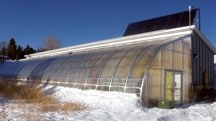It's not ready for big business yet, says an expert, but solar power is now growing salad for high-school students in B.C.
About 80 people went to Grant MacEwan University Wednesday night to hear renewable energy advocate Bill Swan speak about solar greenhouse design.
Swan and the Groundswell Network Society have built a solar-powered greenhouse in Invermere, B.C. Run by students at a local high school, the building uses solar energy for heat, hot water and electricity, and uses other green practices like rainwater collection and organic gardening.
"We're finding that it's a very fast production system," he said. "You can seed and be eating salad in three weeks in there."
Growing better people
Our food system is very energy intensive, Swan said. Whereas most vegetables used to be raised locally, they're now shipped from hundreds of kilometres away at great cost — we burn about nine calories of fossil fuel energy per one calorie we eat. "There's a lot of carbon debt in that food."
Swan's group built a 3,000-sq.-ft. greenhouse in 2009 as a way to address this problem. Almost all of the work and material was donated, including the two gas-station-sized diesel tanks used to hold rainwater.
The greenhouse now grows a variety of plants, Swan said, including cucumbers, melons, spinach and tomatoes. "It's the full range of an outdoor garden."
Local high-school students plant, pick, prepare and eat the vegetables as part of a chef training program, raising about $30,000 a year. "It's super-healthy greens."
Staffers hold regular events at the greenhouse to promote local sustainable food, Swan said. Students also do work placements with local farmers.
The operation has also encouraged many locals to set up greenhouses of their own, and taught hundreds of visitors about the importance of local food. "That's the real product," he said — people. "The salad is the bonus we give them for showing up."
Solar tech
The greenhouse gets its heat from an annualized geosolar system, Swan said. Had they paid full cost for materials and labour, it would have cost about $3 per square foot, or about $9,000.
A network of pipes collects hot air from the greenhouse in the summer and blows it underground. Heat leaches into the ground and comes out during the winter months. "It's like living on a hot plate." As a result the greenhouse manages to get up to around 27 C when it's -3 C outside — without burning fossil fuels.
The greenhouse only gets enough light to work well for 10 months of the year, Swan said, and suffers from wild temperature swings — it can bounce from freezing to 28 C in a day. "A conventional grower in a conventional greenhouse would not tolerate the kinds of swings we're getting." His group is thinking about using a wood furnace to even out the temperature spikes.
Greenhouse operators are very interested in renewable power due to the high cost of winter heating, said Jim Hole of Hole's Greenhouses & Gardens, noting many shut down for the winter to save money.
"What you're seeing out in the marketplace now is people using biofuels," he said — sawdust-fired boilers, for example — as well as better insulation.
Commercial growers have yet to jump onto annualized geosolar, Hole said, but he knew of some greenhouses in China that used thick earth walls to trap solar heat in a similar manner. A demonstration greenhouse in Holland is also testing the technology.
A solar greenhouse would likely need a backup heating system to survive Alberta's cold winters, Hole said, so he wasn't sure if it would catch on here. "You'd have to have pretty deep pockets to do those."
Even if it needs some extra heat in Alberta, Swan said, a solar greenhouse would still save you a lot of energy. "You have to look at the increments of conservation."




